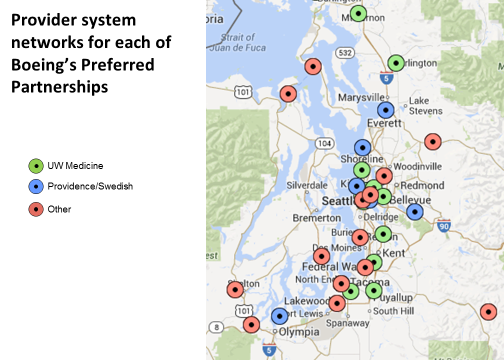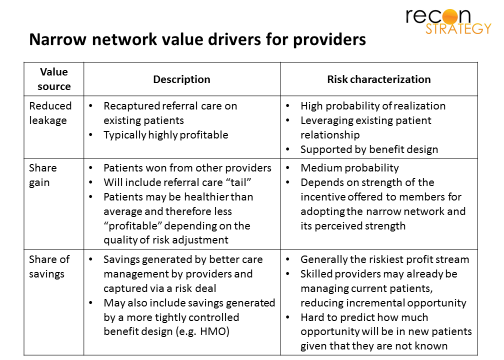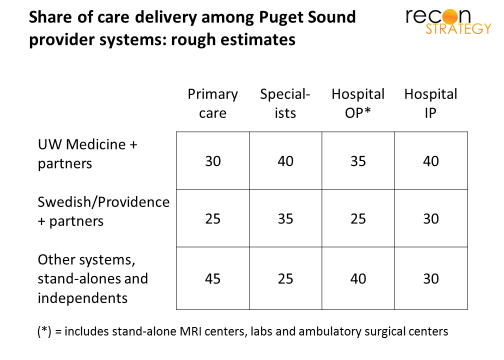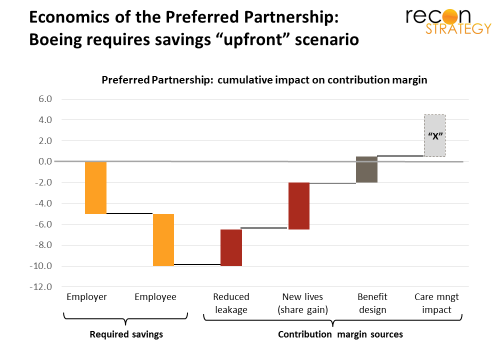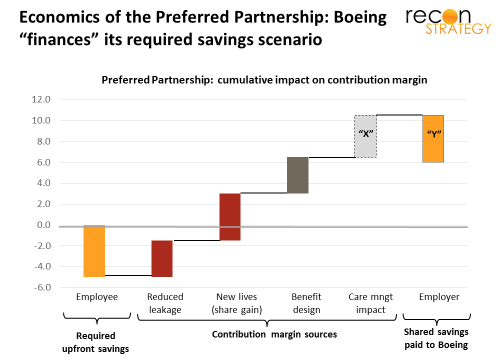Summary
- Boeing is creating a benefit design model which sets up providers to compete for their book of lives via provider-branded narrow networks
- By offering a choice among competing narrow and full network products, the model may make narrow networks more palatable for employees
- Narrow networks can produce a volume windfall for providers (e.g., share gain, leakage reduction) and profits from better care management and a risk deal
- Providers “pay” for the narrow network opportunity by being lower cost (often via incremental discounts) in hopes that these gains outweigh cannibalization (profits lost on current patients who transition to the narrow network product)
- Having multiple narrow network offerings competing for lives in one account, however, means that the pool of “available” patients (not already seeing a provider in a narrow network) is smaller. Therefore, any network “windfall” must be shared (diluted), while likely cannibalization costs remain the same
- As a result of the narrow network model, participating providers will need to focus more on care management to earn back any incremental discounts
Boeing is setting up two constellations of providers in the Puget Sound area to compete for lives both vs. each other and vs. a full network alternative. Starting next year, two new narrow plans will be added as plan options for their non-union employees and retirees (note: I am using narrow network broadly for any product which uses network design to dis-incentivize members’ use of a portion of the locally available delivery system). Each plan is centered on a different, competing alliance of providers led by two of the most prominently branded providers in the area: Swedish/Providence (“S/P”) in one network and UW Medicine (“UW”) in the other.
This is not the first time Boeing has tried an activist network strategy. In 2006, Boeing tried to narrow the network (based on cost and quality criteria that ended up being controversial) for its unionized employees, but then abandoned the effort in the face of strong pushback from employees and providers. This time, unionized employees are not eligible (at least for now), the narrow networks are branded (and presumably developed in collaboration) with prominent providers and, most interesting, there are two of them competing for lives.
Exposing providers to market forces via branded products within a single book of lives is innovative (one precedent is Medica’s My Plan, but this was built for a private exchange channel). As I see it, having competing networks leaves little room for the providers to sit back and reap the profit from share gains and places a greater burden on effective care management to make them more than whole from the deal. It is a bold bet by all the keys stakeholders, but especially for the two providers with the vision to put their capabilities (and brands) to the test.
Economics of narrow networks centered on a high performing system
Narrow network products must balance competing economic requirements:
The products must offer enough value to the plan sponsors to be worth the effort to change benefits. A rule of thumb is a ~8-10% reduction in medical costs to attract employers. Large group and ASO accounts may only need 4-5% savings to find the deal attractive, but with more dispersed populations, they usually need to keep a full network option in the mix. Employees will therefore also need an incentive to select the narrow network, likely also in the range of 4-5%. For example, if they choose the narrow network, employees might see an incremental $500 contribution to their HSA worth 4-5% of medical costs assuming an average ~2.2 members per employee.
The value required by plan sponsors is usually “locked in” upfront either by including only low cost providers or – especially with marquee providers – via incremental discounts applicable to patients in the product. Incremental rate reductions come straight out of provider profits. Providers must anticipate that new profits – usually from a combination of three broad sources – will exceed this cannibalization in order for the decision to make economic sense.
Let’s walk through a thought experiment for how the Preferred Partnerships strikes the balance within these constraints, particularly given the competitive innovation.
How does competition among narrow networks address the constraints?
The provider systems at the center of the new products – S/P and UW – are prominent in the greater Seattle area. Each has gathered a number of other providers to build out its network to provide good coverage throughout Puget Sound (with pockets – such as Everett and Tacoma – where one provider system has heavier presence than the other). Here is how we estimate the rough market shares of the ACO systems:
With these share estimates and some straw man modeling assumptions, it is possible to posit some bold estimates for most of the key components of the economics. (One note: profit is modeled as contribution margin using generic assumptions, not as net profit with fixed costs included. Lives eligible for this product are about 30K or so, and the potential resulting volume swings are unlikely to require changes in the fixed asset structure. So contribution margin is the right way to look at the deal.)
Savings to plan sponsors and members / cannibalization cost for providers
The incremental discounts must be paid on all volume from participating patients. Let’s assume for this analysis each provider must deliver a minimum 8% medical cost reduction on the patients they treat — ~4% for Boeing as sponsor, ~4% as inducement for employees to sign up for the product. In point of fact, Boeing has announced that single employees could save $360-$400 per year in employee plan contributions or $800-$1080 for a family if they choose a Preferred Partnership product (and more on co-pays).
This would imply that the negative contribution margin impact of cannibalization could be 10% of revenues on all participating Boeing lives (recall that drugs are part of medical costs and the provider discounts only apply to their 80% of the care bill) – the same as the provider systems offering a 10% price reduction on a per service basis. (Note: I am also assuming any marquee rates which highly branded providers may charge are diluted by other participating providers in each of the network constellations, so the average rate-based cost of a patient is the same whether currently with UW, S/P or other unaligned providers).
Gain on reduced leakage
Boeing currently has a PPO product structure, so there is likely a fair amount of leakage across provider systems. Not all of that care is realistically “gettable,” but even so, reduced leakage could potentially bring in 17-20% higher revenues for each system if they can hold on to their current referral care. However, in the new model, at the same time that UW is repatriating care out of S/P, S/P is repatriating care out of UW, thus blunting the impact for both. Actual leakage reduction will probably net out at about half (our guess is 7-10% of revenues among participating lives) adding a contribution margin worth 3-4% of total revenues (recall leakage is about referred care with typically high contribution per dollar of revenues – especially on facilities portion care).
Share gain among new patients
New lives for the provider systems must come from the ~45% patients among the “non-aligned” primary care providers. Any attracted members would likely split across UW and S/P, blunting the share gain potential. Finally, it is important to keep in mind that UW and S/P are heavy referral care centers, so they are already serving a portion of these patients’ care at their facilities (typically the more profitable portion). Thus, there would be no net gain on that care (in fact some cannibalization is likely, given the discounts). In the context of these limitations, our guess would be that the equivalent of ~1 in 3 members joining the product would be new to the two systems (over the long-term), adding a contribution margin gain of 4-5% of revenues for each system.
Share of savings from lower utilization / better management
There are two elements that could contribute to lower utilization: benefit design and provider care management strategies. Changing the benefit design from PPO (the current model) to more of a managed could drive a utilization reduction of 2-3% of medical costs (Boeing has described the products as not requiring a primary care referral but it does appear that primary care providers are being supported in taking a more active role in managing their patients with much lower co-pays for visits). Potential savings from better care management is hardest to predict. This is particularly true because both the UW and S/P networks include a lot of independent provider groups and the systems will need to learn how to collaborate with each other. Let’s leave that as an “X” for now and see where we stand.
Notably, the value of utilization reduction will be quite high for the systems, since leakage reduction and share gain provide new volume to fill any lost as a result of lower utilization. The value will depend on the reimbursement arrangement with Boeing. Given the assumption that Boeing got savings locked in upfront (via the incremental discount), the share of savings may be quite high. Let’s assume providers can get 60% of the savings, so the contribution margin impact for providers will be worth 2-3% of revenues at a minimum (benefit design) plus some 60% of “X”.
The exhibits below summarize the net contribution margin impact (keep in mind that each of the bars in the graph have a large error around them). At a high level, the volume windfalls coming out of the narrow network structure will barely, if at all, make the providers “whole” for the incremental discounts. As a result, the lion’s share of their profit on the product must come from utilization reductions.
Of course, there are different ways the arrangement could actually be structured. For example, Boeing might help “finance” the deal by forgoing its share of the upfront savings, requiring only that the employee incentives be locked in via discounts and then taking a greater share of the utilization savings on the back end (in the exhibit below, this would be “Y”, some sizeable portion of benefit design and care management impact on cost) This approach would have the benefits of (1) assuring the providers some minimal profitability on the deal on a contribution margin basis (the value of the volume windfall being greater than the employee savings hit) and (2) keeping incentives aligned for both Boeing and the providers to collaborate on continually reducing utilization.
Either way, the providers must deliver on the care management to make real money as a result of having to share the volume windfall with each other. And Boeing will have started developing the infrastructure for transitioning more of its employees out of open PPO products into more tightly managed networks (e.g., by offering these options to unionized employees next) and expanding the degree to which providers compete in a market place based on value (the stronger the savings offered by providers, the greater the share gain potential).
There is one secondary point worth keeping in mind. Leakage is often as much about provider behavior as it is about consumer preferences. Providers also famously tend to ignore the payer when adhering to a care workflow. Therefore, to the extent new habits are learned about advising patients where to get care within the Preferred Partnership, there may be an additional benefit to the providers of reducing leakage for other patients as well. That’s a long-term bet I would not recommend considering as part of the deal analysis, but may weigh on the minds of some provider executives.
Implications
- Boeing’s model may be useful to replicate in other markets where there are a few competing, strongly branded providers whose exclusion from a narrow network option would doom it.
- By applying a distinctive provider brand to each network, the model starts to expose providers to more typical market forces
- While Boeing may be strengthening the market position of the participating providers under the “old” provider-employer negotiated model, it is also setting up its market to transition to a provider-consumer type of market
- We do not expect it to be too long before Boeing starts transitioning its employees to defined contribution. UW, S/P and other provider systems not part of the current narrow network constellations but highly dependent on Boeing for their revenues should focus quickly on developing a retail strategy

